Amphibians
There are several species of tree frogs in the Virgin
Islands. Their calls (mixed with those of insects)
provide a musical background to the night,
especially after an early evening rain
shower. Male frogs call to attract females
for mating.
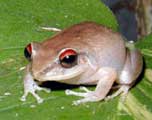 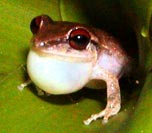 Tree Frog (Eleutherodactylus antillensis)
|
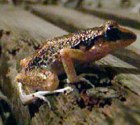 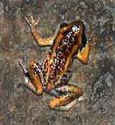 Tree Frog (E. lentus)
Eggs are deposited in moist, protected areas or
small accumulations of standing water in and
around plants. In at least one species
(the coqui frog), the adult male will help keep
the eggs moist and guard them from predators.
|
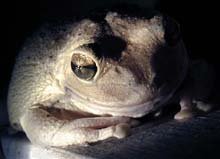 Cuban Tree Frog (Osteopilus septentrionalis)
|
The Cuban tree frog originated in Cuba, but was
introduced to the Virgin Islands as recently as the
early 1970's. It was first seen on St. Croix, then
St. Thomas, now it is found on St. John as well.
It is likely that this frog's range will continue to
increase to other islands in the near future - if it
hasn't already. It's large size (approximately three
inches in body length) makes it easy to distinguish
from other tree frogs in the Virgin Islands.
Mucus on the frog's skin is toxic to humans,
causing serious reactions to the eyes, nose,
and mouth. Handling of these frogs is discouraged.
|
Reaching a body length of up to ten inches and
a weight of up to two pounds, the sugarcane
toad is one of the largest toads in the world.
Native to South and Central America, these
toads are now found throughout tropical and
sub-tropical regions everywhere sugar has
been grown.
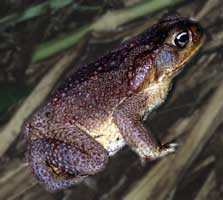 Sugarcane Toad (Bufo marinus)
|
They are voracious eaters that feed mainly
on insects, but will include a wide range of foods in
their diets - eating just about anything that will fit
inside their mouths.
The pictured toad could frequently be seen at night
stationed near a bowl of cat food, waiting to catch
the insects the food would attract. In an attempt to
discourage the toad from it's antics (the cats did
not appreciate it's presence) the cat food was
repeatedly moved to various locations,
even up and down a large staircase.
Within one to two nights, the toad would always
locate the bowl of food and resume it's activities.
The large toad was quite adept at climbing and
descending stairs.
Sugarcane toads have large glands behind their
eyes that can secrete a very powerful toxin.
Handling of these toads is strongly discouraged.
Other names for the sugarcane toad are
giant toad, crapaud, and kwappo.
|
